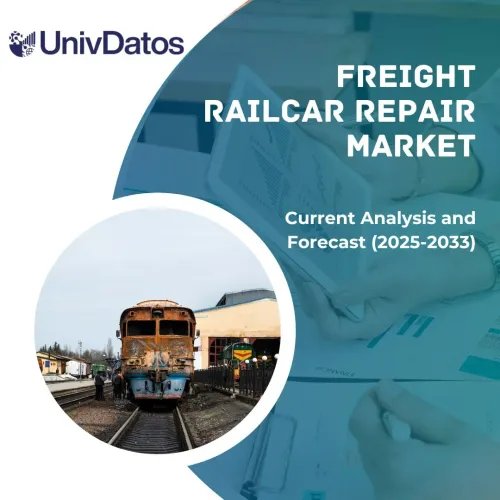- Home
- About Us
- Industry
- Services
- Reading
- Contact Us
Autonomous Trucks Market: Current Analysis and Forecast (2024-2032)
Emphasis on Type (Light Trucks, Medium Trucks, Heavy Trucks); Level of Autonomy (Semi-Autonomous, Fully Autonomous); Component (LiDAR, RADAR, Camera, Sensors) By Propulsion (ICE, Electric, Hybrid) and Regions (North America (The US, Canada, Rest of the North America), Europe (The UK, France, Germany, Italy, Spain, Rest of the Europe), Asia-pacific (China, Japan, India, Australia, Rest of the Asia-pacific), Rest of the World)
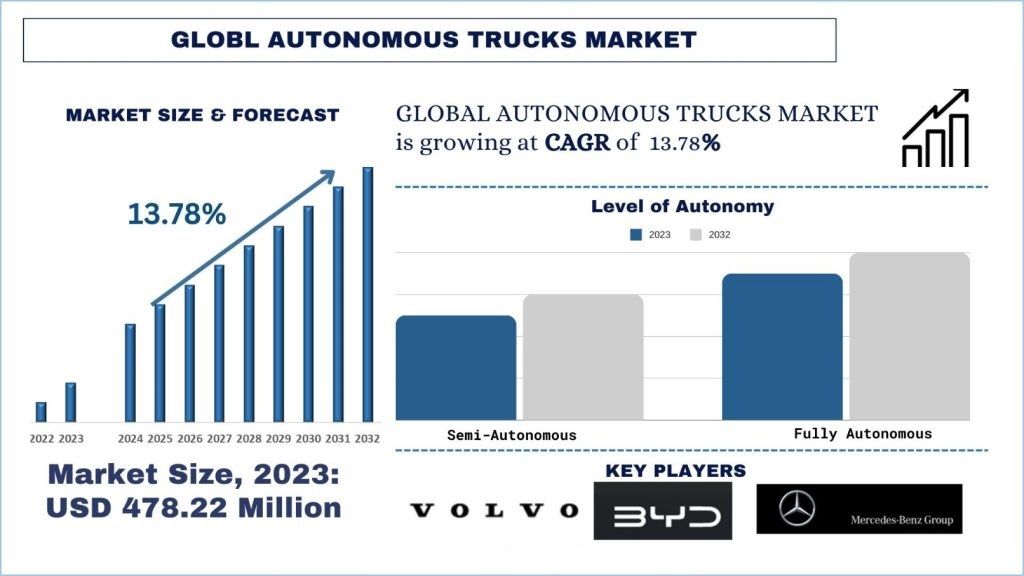
Global Autonomous Trucks Market Size & Forecast
The Global Autonomous Trucks market was valued at USD 478.22 million in 2023 and is expected to grow at a strong CAGR of around 13.78% during the forecast period (2024-2032), owing to rising investments in sustainable mobility solutions and growing technological advancements.
Global Autonomous Trucks Market Analysis
Autonomous Trucks are next-generation transportation vehicles equipped with a combination of drive assistance components such as LiDAR, RADAR, Camera, and various types of sensors in combination with robust predictive guidance software that helps the vehicle to drive with little to no human interference. Considering the increasing road accidents as well as curbing operational costs, many fleet management companies have started opting for autonomous trucks. Some of the factors that have contributed to the market growth are shortages of drivers, reduced operational costs, and curbing downtime during goods transportation. Alongside these factors, many of the leading truck manufacturers have also undergone collaboration and strategic partnerships with the autonomous driving solutions provider, which has further instigated the demand with the availability of a growing number of options in the autonomous trucks market.
In 2021, Volvo Autonomous Solutions and Aurora announced their partnership to jointly develop highway autonomous trucks (class 8 trucks). This prototype includes a Volvo truck long-haul VNL model integrated with Aurora Driver Technology.
Global Autonomous Trucks Market Trends
This section discusses the key market trends that are influencing the various segments of the Global Autonomous Trucks Market as identified by our team of research experts.
Collaborations Among Truck Manufacturers & Autonomous Driving Technology Providers
Collaboration between autonomous driving technology providers and truck manufacturing companies is pivotal to developing autonomous trucks. These collaborations are also in line with the upcoming development of autonomous trucks for mass production. For instance, in 2024, Isuzu, one of the leading automotive manufacturers, announced its partnership with Gatik Fleet to mass-produce the SAE Level 4 autonomous trucks. As a part of this, Isuzu invested USD 30 million in the Gatik Fleet for the fully driverless autonomous truck.
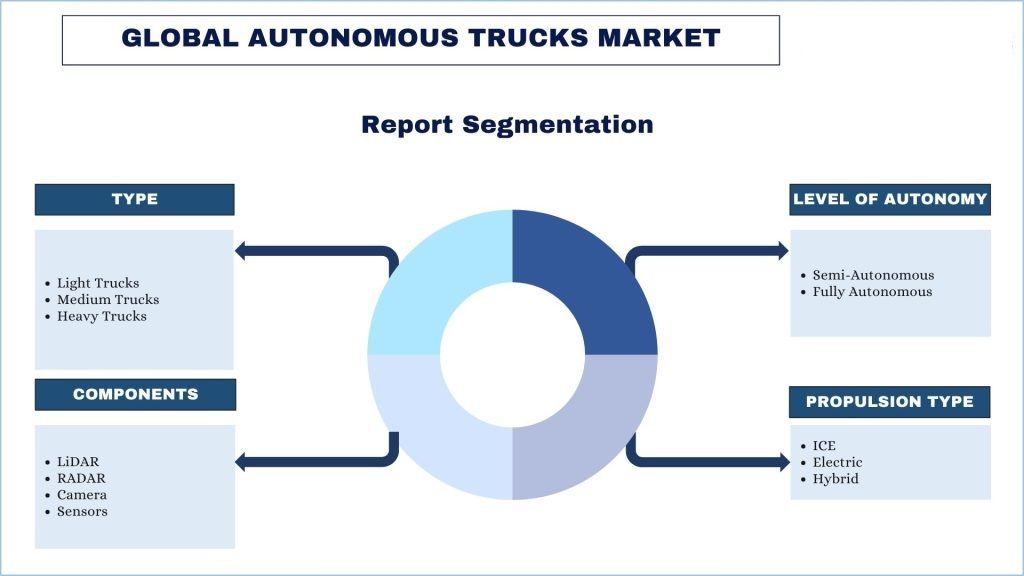
North America is Expected to Grow with Significant CAGR During Forecast Period
North America is home to one of the largest markets for commercial vehicles. Additionally, there is a thriving market for e-commerce and food delivery services in the country that has significantly supported the demand for trucks and other smaller commercial vehicles. Many companies, including both conventional truck and autonomous truck manufacturers, are actively working to develop a full-fledged autonomous truck technology. Additionally, many companies are conducting pilot projects and testing autonomous trucks. These tests aimed to validate the technology, assess safety and reliability, and gather real-world data to improve autonomous systems.
Additionally, the region is also a pioneer in terms of the adoption of regulatory policies that have noticeably assisted in the development and testing of new-age autonomous vehicles. For instance, the US-based Aurora Innovation raised USD 853 million has announced to launch of its vehicles by late 2024. The company is hauling more than 50 loads per week from Houston to El Paso for pilot customers such as FedEx, Schneider, Werner Enterprises, Uber Freight, and Hirschbach.
Global Autonomous Trucks Industry Overview
The Global Autonomous Trucks market is competitive and fragmented, with the presence of several global and international market players. The key players are adopting different growth strategies to enhance their market presence, such as partnerships, agreements, collaborations, new product launches, geographical expansions, and mergers and acquisitions. Some of the major players operating in the market are Volvo AB, BYD Co Ltd, Traton SE, Mercedes Benz Group, Tesla, Daimler Trucks, Waymo, Paccar, Embark, and TuSimple.
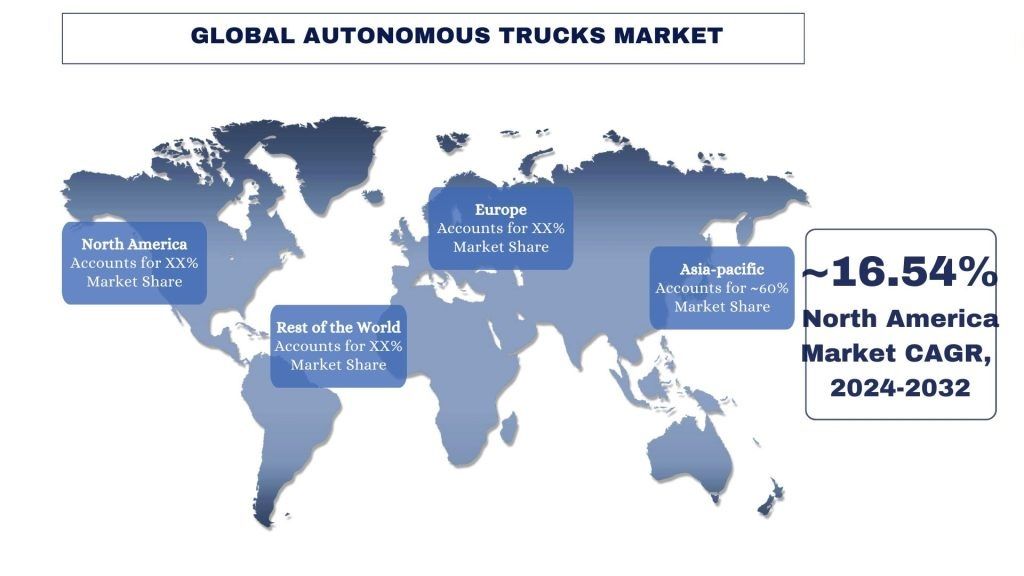
Global Autonomous Trucks Market News
- In 2024, Navistar Inc. and Plus, an autonomous driving technologies provider, announced their partnership to bring self-driving trucks to US roads. According to Plus, it will use its class 4 autonomous trucks in trucks of Scania, Man, and Navistar in Europe and the USA.
- In 2021, Volvo Autonomous Solutions and Aurora announced their partnership to jointly develop highway autonomous trucks (class 8 trucks). This prototype includes a Volvo truck long-haul VNL model integrated with Aurora Driver Technology.
Global Autonomous Trucks Market Report Coverage
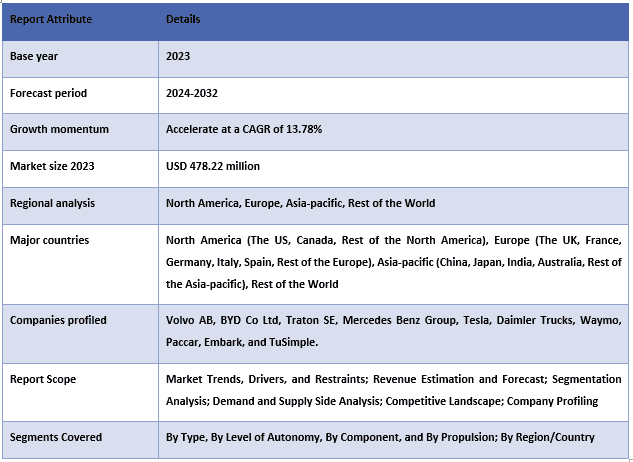
Reasons to buy this report:
- The study includes market sizing and forecasting analysis validated by authenticated key industry experts.
- The report presents a quick review of overall industry performance at one glance.
- The report covers an in-depth analysis of prominent industry peers with a primary focus on key business financials, product portfolios, expansion strategies, and recent developments.
- Detailed examination of drivers, restraints, key trends, and opportunities prevailing in the industry.
- The study comprehensively covers the market across different segments.
- Deep dive regional level analysis of the industry.
Customization Options:
The Global Autonomous Trucks market can further be customized as per the requirement or any other market segment. Besides this, UMI understands that you may have your own business needs; hence, feel free to connect with us to get a report that completely suits your requirements.
Table of Content
Research Methodology for the Global Autonomous Trucks Market Analysis (2024-2032)
Analyzing the historical market, estimating the current market, and forecasting the future market of the Global Autonomous Trucks market were the three major steps undertaken to create and analyze the adoption of Global Autonomous Trucks in major regions globally. Exhaustive secondary research was conducted to collect the historical market numbers and estimate the current market size. Secondly, to validate these insights, numerous findings and assumptions were taken into consideration. Moreover, exhaustive primary interviews were also conducted with industry experts across the value chain of the Global Autonomous Trucks market. Post assumption and validation of market numbers through primary interviews, we employed a top-down/bottom-up approach to forecasting the complete market size. Thereafter, market breakdown and data triangulation methods were adopted to estimate and analyze the market size of segments and sub-segments of the industry. Detailed methodology is explained below:
Analysis of Historical Market Size
Step 1: In-Depth Study of Secondary Sources:
A detailed secondary study was conducted to obtain the historical market size of the Global Autonomous Trucks market through company internal sources such as annual reports & financial statements, performance presentations, press releases, etc., and external sources including journals, news & articles, government publications, competitor publications, sector reports, third-party database, and other credible publications.
Step 2: Market Segmentation:
After obtaining the historical market size of the Global Autonomous Trucks market, we conducted a detailed secondary analysis to gather historical market insights and share for different segments & sub-segments for major regions. Major segments are included in the report by type, by level of autonomy, by component, and by propulsion. Further regional/country-level analyses were conducted to evaluate the overall adoption of testing models in that region.
Step 3: Factor Analysis:
After acquiring the historical market size of different segments and sub-segments, we conducted a detailed factor analysis to estimate the current market size of the Global Autonomous Trucks market. Further, we conducted factor analysis using dependent and independent variables such as type, by level of autonomy, by component, and by propulsion of the Global Autonomous Trucks market. A thorough analysis was conducted for demand and supply-side scenarios considering top partnerships, mergers and acquisitions, business expansion, and product launches in the Global Autonomous Trucks market sector across the globe.
Current Market Size Estimate & Forecast
Current Market Sizing: Based on actionable insights from the above 3 steps, we arrived at the current market size, key players in the Global Autonomous Trucks market, and market shares of the segments. All the required percentage shares split, and market breakdowns were determined using the above-mentioned secondary approach and were verified through primary interviews.
Estimation & Forecasting: For market estimation and forecast, weights were assigned to different factors including drivers & trends, restraints, and opportunities available for the stakeholders. After analyzing these factors, relevant forecasting techniques, i.e., the top-down/bottom-up approach, were applied to arrive at the market forecast for 2032 for different segments and sub-segments across the major markets globally. The research methodology adopted to estimate the market size encompasses:
- The industry’s market size, in terms of revenue (USD) and the adoption rate of the Global Autonomous Trucks market across the major markets domestically
- All percentage shares, splits, and breakdowns of market segments and sub-segments
- Key players in the Global Autonomous Trucks market in terms of products offered. Also, the growth strategies adopted by these players to compete in the fast-growing market.
Market Size and Share Validation
Primary Research: In-depth interviews were conducted with the Key Opinion Leaders (KOLs) including Top Level Executives (CXO/VPs, Sales Head, Marketing Head, Operational Head, Regional Head, Country Head, etc.) across major regions. Primary findings were then summarized, and statistical analysis was performed to prove the stated hypothesis. Inputs from primary research were consolidated with secondary findings, hence turning information into actionable insights.
Split of Primary Participants in Different Regions

Market Engineering
The data triangulation technique was employed to complete the overall market estimation and to arrive at precise statistical numbers for each segment and sub-segment of the Global Autonomous Trucks market. Data was split into several segments & sub-segments post studying various parameters and trends in the areas of as type, by level of autonomy, by component, and by propulsion in the Global Autonomous Trucks market.
The main objective of the Global Autonomous Trucks Market Study
The current & future market trends of the Global Autonomous Trucks market were pinpointed in the study. Investors can gain strategic insights to base their discretion for investments on the qualitative and quantitative analysis performed in the study. Current and future market trends determined the overall attractiveness of the market at a regional level, providing a platform for the industrial participant to exploit the untapped market to benefit from a first-mover advantage. Other quantitative goals of the studies include:
- Analyze the current and forecast market size of the Global Autonomous Trucks market in terms of value (USD). Also, analyze the current and forecast market size of different segments and sub-segments.
- Segments in the study include areas of as type, by level of autonomy, by component, and by propulsion.
- Define and analyze the regulatory framework for the Global Autonomous Trucks
- Analyze the value chain involved with the presence of various intermediaries, along with analyzing customer and competitor behaviors of the industry.
- Analyze the current and forecast market size of the Global Autonomous Trucks market for the major regions.
- Major countries of regions studied in the report include North America (The US, Canada, Rest of North America), Europe (The UK, France, Germany, Italy, Spain, and Rest of Europe), Asia-pacific (China, Japan, India, Australia, Rest of the Asia-pacific), Rest of the World
- Company profiles of the Global Autonomous Trucks market and the growth strategies adopted by the market players to sustain in the fast-growing market.
- Deep dive regional level analysis of the industry
Frequently Asked Questions FAQs
Q1: What is the current market size and growth potential of the Global Autonomous Trucks market?
Q2: What are the driving factors for the growth of the Global Autonomous Trucks market?
Q3: Which segment has the largest share of the Global Autonomous Trucks market by type?
Q4: Which region will dominate the Global Autonomous Trucks market?
Related Reports
Customers who bought this item also bought









